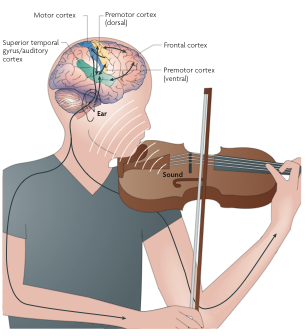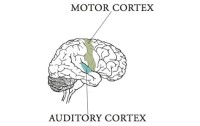Ohad (Udi) Bar-David, cellist with the Philadelphia Orchestra, says that when he first began playing with Arab musician Simon Shaheen, it was difficult to play the microtones that are prevalent in Arab music. “But,” he says, “when you start hearing it, your fingers just take you there.”
Your fingers “just take you there” because of the strong auditory-motor connection in the brain.
When we make music, we are translating musical notation into movement that results in sound (or we improvise – sound production is still the same). When we use movement to produce a sound on our instrument, the vibrations are changed into neural impulses by the inner ear and sent to the auditory cortex in the brain, where they are processed.

Info from the auditory cortex is sent to the pre-motor cortex where motor plans are made. Those plans are then sent to the motor cortex where they are turned into neural commands that are sent down nerves along the spinal cord and to our muscles. Our muscles enable us to make more movements at our instrument, resulting in more sound and the whole process continues to repeat – practically instantaneously. Sound-movement-sound-movement.
Not surprisingly, “sound to movement to sound” is called the auditory-motor loop, and it is of crucial importance to musicians because what we do is produce sound through movement. We can hear a pattern in our minds and know what movements we have to make to realize that pattern. We hear a singing legato, or a sharp staccato in our minds, and we know the kind of motion we need to make to generate that sound.
This is the importance of the auditory-motor connection. We match our movements at our instruments to the sounds we want to hear.
Until a few centuries ago and still the case today in many cultures, there was, or is, no divide between hearing music and making music. No one is a listener, everyone a participant. So from a biological perspective, a strong connection developed between making music and hearing it – between sensory-motor and auditory processing.
And scientists say that this biological connection probably originally existed because, in primitive cultures, sounds often meant danger. If you heard a sound in the brush, you better not stop to figure out whether it was a rabbit or a lion. Your brain was programmed to have you run first – think later.
In musicians, years of practicing make the auditory-motor connection stronger. Brain imaging of musicians shows that the auditory-motor connection goes in both directions – from auditory to motor and from motor to auditory.
 Scans of pianists’ brains as they listened to music that they had played or knew well showed that not only was the auditory cortex active, but so was the motor cortex, even though no movement was involved.
Scans of pianists’ brains as they listened to music that they had played or knew well showed that not only was the auditory cortex active, but so was the motor cortex, even though no movement was involved.
And a study of German violinists fingering silently several bars of the Mozart G major violin concerto showed activity in the primary auditory regions (missing in amateurs in the study). So silent motor activity also activates the auditory portion of the brain.
But what is really interesting is that this co-activity in auditory and motor regions shows up after only 20 minutes of practice. In one research study, beginners were taught a simple melody and after only 20 minutes, there were changes in the auditory-motor connection in their brains. After 5 weeks of practice, the connection was firmly established.
Musical training triggers almost instant changes in the auditory-motor connection in our brains. And these changes in the auditory-motor connection due to learning are called plasticity.
We will return to plasticity, or changes in the brain, in another post, but since everything in the brain is connected, it’s important to understand the strong auditory-motor connection before talking about auditory mirror neurons – which will be in the next post.
2 responses to “Setting the stage for auditory mirror neurons: the auditory-motor loop”
Wonderful! Given the fairly recent info concerning decision-making and ‘free will’, it will be interesting to see just when the motor decisions are made relative to the input.
Yes, the new info on “free will” is interesting. And there is research in error detection that shows that the brain knows we will make a mistake before it happens. That certainly is something for musicians to think about.